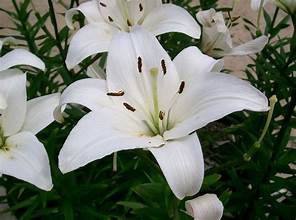Lily flowers, one of the most popular summer garden bulbs, bloom brightly while many other flowers are dormant. Lilies are well-known for their intoxicating smell, sturdy stems, and large petals, but they also make excellent cut flowers.

Scientific Classification
Kingdom: Plantae
Order: Liliales
Family: Liliaceae
Genus: Lilium
Basics Conditions for Growing Lily flowers
Sun exposure
They require at least six hours of direct sunlight every day and prefer sheltered roots, which can be obtained by planting them among low-growing plants.
Soil type
Lilies prefer rich, well-drained soil with a pH of 5.5 to 6.5, and they thrive in berms or raised beds to guarantee appropriate drainage, however Orienpet lilies are less demanding of soil nutrients.
Various types of Lily Flowers
Although there are many different kinds of lilies, these are some of the more popular ones:
- Asiatic lilies can produce up to 12 blossoms per bulb and bloom in a wide range of colors from early to midsummer.
- Border lilies are smaller, reaching heights of 14 to 18 inches, and blooming from early to late summer.
- Double lilies bloom in the early to late summer, have layered petals, and are often pollen-free.
- Longiflorum lilies, often known as Easter lilies, are typically induced to bloom in the spring and have white, trumpet-shaped blossoms.
- Oriental lilies bloom from mid- to late-summer and are admired for their scent and huge, 6 to 9-inch petals.
- Orienpet lilies, sometimes referred to as enormous lilies, bloom in early to midsummer and reach heights of 36 to 72 inches.
How to plant Lily Flowers (Bulbs)
Although they can be planted in the spring, lily bulbs benefit from a head start when planted in the autumn. Planting them at least 8 to 10 inches deep from the top of the bulb to the soil surface is crucial since they are stem rooters and the bulbs support hefty flowers. If you live somewhere where the temperature is usually higher than 90 degrees Fahrenheit, plant the bulbs four inches deeper.
Gardening Advice:
- To provide adequate drainage, plant lilies in a raised bed or berm.
- Plant lilies in clusters of three or more bulbs for maximum visual impact.
- Plant lily bulbs on their side to prevent rotting in locations with heavy rains.
- Fill the planting hole with some garden lime if your soil is naturally acidic.
Life Care
Especially in the winter, protect lilies from animals, voles, and insects. Early in the spring, begin patrolling for red lily beetles and destroy them right away. To prevent breaking the stems or bulbs, stake lilies before the flowers become heavy.
Trim only 1/3 of the stem when cutting lilies for bouquets so that the bulbs can be replenished for the next year. To avoid stains, remove the anthers before bringing them indoors. Trim flower stems after flowering, but keep foliage until it turns brown and dies to help bulbs store energy for the following season.
Varieties of lily flower
Casa Blanca’ Lily

A fragrant cluster of ‘Casa Blanca’ lilies gives beauty to a white flower garden. ‘Casa Blanca’ is an Oriental hybrid notable for its large, waxy petals, which make it popular in cut flower arrangements, particularly wedding bouquets. Staking or a protected location can help prevent stem breakage. It blooms in mid- to late summer, producing strongly scented flowers.
Turk’s Cap Lily

For avant-garde gardeners looking for unusual possibilities, the ‘Turk’s cap’ lily (Lilium ‘Martagon) from Asia, also known as the ‘Martagon’ lily, is an intriguing choice. Its stems include numerous layers of flowers, some of which are speckled, and form a pagoda-like appearance. These lilies are more shade tolerant than others and should be planted in well-drained soil in the autumn. They may not blossom in the first season since they establish slowly. Along with native species, hybrid variants are the outcome of crossbreeding with comparable species.
Tiny Bee’ Lily

‘Tiny Bee’ is a tiny Asiatic hybrid lily that is great for brightening path margins and patio containers. Its tiny size makes it more tolerant in windy situations than taller types. Blooming in midsummer, it gives vitality to any garden setting.
Tiger Lily

Tiger lilies (Lilium ‘Lancifolium‘) are hardy and long-lasting, making them an ideal choice for inexperienced gardeners. Throughout the summer, their pendulous blossoms, embellished with lovely freckles, bloom in a variety of colours, most notably orange. They originated in Asia and flourish in the Northeast, blooming in the mid- to late summer.
Easter Lily

Sometime in March, you may notice containers of gorgeous white lilies appearing everywhere, not just at the garden centre. The so-called estren lily (Lilium ‘Longiflorum‘), native to Southern Japan and Taiwan, represents purity and rebirth for Christians but can brighten your landscape long after the Easter bunny has left the building. This is a true species lily, not a hybrid, however it has served as a parent species for several trumpet-type hybrid lilies. Plant them in a sunny, well-drained area in your garden. When planted in the garden, they can bloom for years, typically in July and August.
Conclusion
Looking to brighten up your garden with the colorful splendor of lily flowers? This guide has got you covered! Lilly flowers are admired for their attractive smell and magnificent array of colors, making them essential for any summer garden. For best results, ensure your lilies receive full sunlight and are planted in well-drained soil in the autumn, with bulbs buried at least 8 inches deep. Explore popular kinds such as Asiatic, Oriental, and Easter lilies, each of which will offer a particular beauty to your outdoor sanctuary. With proper care, including regular watering and pest control, your lilies will thrive and become the center point of your garden. When gathering flowers for a bouquet, don’t forget to remove the anthers and trim off only a third of the stem to prevent stains in your arrangements. Explore the world of lilies and see how their classic elegance may transform your garden!



Pingback: African Daisy , how to Grow and Care
This blog was… how do I say it? Relevant!! Finally I’ve found something that helped me.
Thanks! https://Odessaforum.biz.ua/
You are welcome and thanks for appreciating me.
This blo was… how do I say it? Relevant!! Finally I’ve found
something that helped me. Thanks! https://Odessaforum.biz.ua/
You are welcome and thanks for appreciating me.